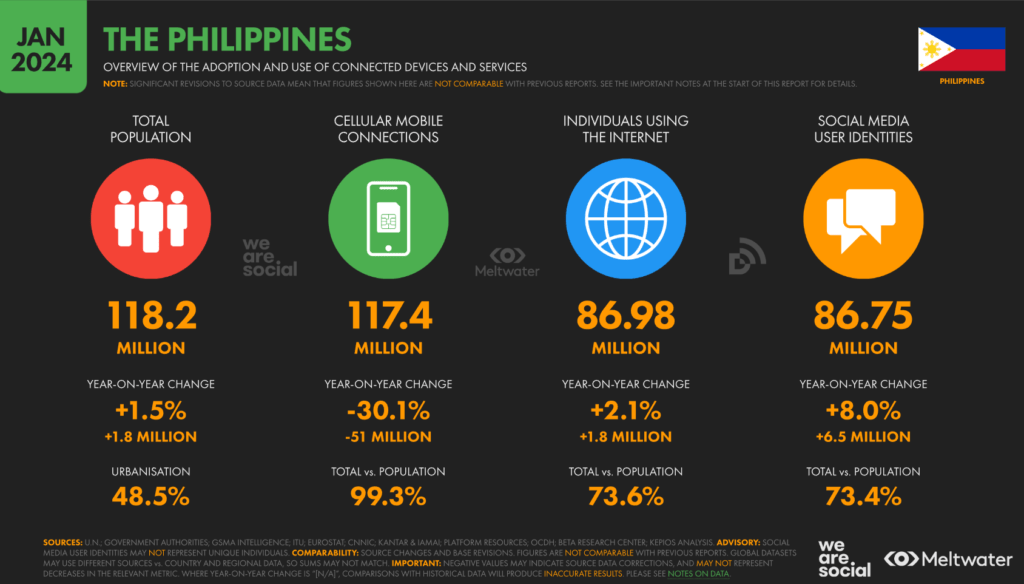The Philippines has demonstrated remarkable resilience in its economic recovery post-pandemic, driven largely by an impressive rate of digital adoption. As we explore data derived from our Market Research Philippines Trends Q1 & Q2 2024, it becomes evident that these two factors have significantly shaped the nation’s economic landscape in the first half of 2024.
Economic Recovery: A Steady Climb
The economic recovery of the Philippines has been a steady climb, characterized by a combination of government initiatives, private sector resilience, and a robust consumer base. The Gross Domestic Product (GDP) growth rate has been on an upward trajectory, reflecting a rebound from the pandemic-induced slump. Key sectors such as manufacturing, construction, and services have played pivotal roles in this recovery.
Government policies aimed at stimulating economic activity, such as infrastructure projects under the “Build, Build, Build” program, have been instrumental in creating jobs and boosting economic output. The private sector’s adaptability, particularly in shifting to digital platforms, has also been a significant contributor to the recovery.
Digital Adoption: A Catalyst for Growth
One of the most striking trends in the first half of 2024 in the Philippines is the high rate of digital adoption. The pandemic has accelerated digital transformation in a variety of sectors, including retail, finance, education, and healthcare. This has not only helped businesses survive but also prepared them for future growth.
According to DataReportal, internet penetration in the Philippines was 73.6% at the beginning of 2024, with 86.98 million users. The number of Filipinos online increased by 1.8 million between January 2023 and January 2024. Despite this progress, 31.24 million people remained offline, highlighting the need for continued efforts to expand internet access.
Mobile penetration has also been significant, with 117.4 million active mobile connections in early 2024, representing 99.3% of the total population. The widespread availability of internet-capable smartphones has enabled Filipinos to access a variety of services, from eCommerce to digital banking.

eCommerce Boom in the Philippines
The eCommerce sector in the Philippines has been a major driver of the digital economy. In 2022, the gross merchandise value (GMV) of eCommerce reached USD 15 billion, with projections indicating a rise to USD 60 billion by 2030. Marketplaces like Lazada and Shopee have facilitated online shopping, making it easier for Filipinos to purchase items from different brands at affordable prices. These platforms also offer convenient payment options and delivery services.
Digital Banking and Fintech Revolution
The fintech revolution is transforming the financial landscape in the Philippines. Mobile payment solutions, digital wallets, and peer-to-peer (P2P) lending platforms are becoming increasingly popular. Filipino fintech companies like Mynt and PayMongo are leading the way by offering seamless eWallet and eBanking services. These innovations are promoting financial inclusion and providing consumers with convenient transaction methods.
Challenges and Opportunities
While the economic recovery and digital adoption in the Philippines are promising, they are not without challenges. The digital divide remains a significant issue, with rural areas lagging behind in terms of internet connectivity and digital literacy. Addressing these disparities is crucial to ensuring inclusive growth and maximizing the benefits of digital transformation.
Moreover, cybersecurity threats have increased with the rise in digital activities. Businesses and consumers must invest in robust cybersecurity measures to protect their data and maintain trust in digital platforms.
On the other hand, these challenges propose opportunities for expansion and innovation. Enhancing digital infrastructure, promoting digital literacy programs, and strengthening cybersecurity frameworks are essential steps that can propel the Philippines forward.
Looking Ahead
The Market Research Philippines Trends Q1 & Q2 2024 highlights a positive outlook for the Philippines as it continues to recover economically and embrace digital transformation. With sustained efforts from both the government and private sector, the Philippines is well-positioned to leverage these trends for long-term growth and development.
In conclusion, the economic recovery post-pandemic and the high rate of digital adoption are two critical factors shaping the Philippine market in 2024. By addressing the challenges and seizing the opportunities, the Philippines can build a resilient and inclusive economy that thrives in the digital age.

